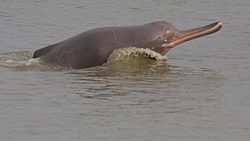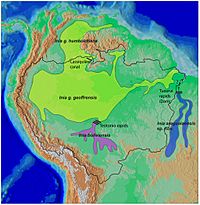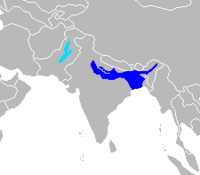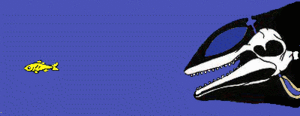River dolphin facts for kids
Quick facts for kids River dolphins |
|
|---|---|
| River dolphins are not a taxon, they are an informal grouping of the infraorder Cetacea | |

Ganges river dolphin Platanista gangetica
|
|
| Information | |
| Families considered river dolphins |
|
| New World range map |  |
| Old World range map |  |
River dolphins are a special group of aquatic mammals. They live only in fresh water, like rivers, or in brackish water, which is a mix of fresh and salt water. They are a type of dolphin, and all dolphins belong to a larger group called Cetacea. There are five types of river dolphins alive today. River dolphins are related to hippopotamuses; they separated from them about 40 million years ago.
River dolphins are smaller than other dolphins. They have changed over time to live in warm, shallow water and strong river currents. They can be from about 5-foot (1.5 m) long, like the South Asian river dolphin, to 8-foot (2.4 m) and 220-pound (100 kg), like the Amazon river dolphin. Some types have males that are bigger than females. They have smooth bodies and two limbs that are like flippers.
River dolphins use their cone-shaped teeth and long beaks to catch fast-moving fish in muddy water. They hear very well both in air and water. They do not rely much on their eyesight because the water they live in is often very muddy. These dolphins are good at living in warm, shallow waters. Unlike other cetaceans, they have very little or no blubber (a layer of fat).
River dolphins do not live in many places. They are found only in certain rivers or river deltas. This makes them very easy to harm if their home is destroyed. River dolphins mostly eat fish. Male river dolphins often mate with many females each year. But females only mate every two or three years. Babies are usually born in the spring and summer. Female dolphins take care of their young by themselves. River dolphins make many different sounds, like clicks and whistles.
It is rare to keep river dolphins in zoos or aquariums. They do not breed well in captivity and often die soon after being caught. As of As of 2015[update], only four river dolphins were living in captivity.
Contents
River vs. Ocean Dolphins
Both river dolphins and ocean dolphins are mammals called cetaceans. River dolphins have a snout that can be about 58 centimeters (23 in) long. This is about four times longer than most ocean dolphins' snouts. They use their long snout to find fish on the muddy river bottom.
River dolphins have smaller eyes than ocean dolphins. Their eyesight is not very good because they live in dark, muddy water. River dolphins are also less active than ocean dolphins. They do not need to swim far to find food. Ocean dolphins often hunt in groups called pods. They work together to catch fish. River dolphins usually hunt alone or in small groups.
Dolphin Body and Senses
How Their Bodies Work

River dolphins have a body shaped like a torpedo. They have a flexible neck, and their limbs are flippers. They do not have outer ear flaps. They have a tail fin and a small, round head. Their skulls have small eye sockets, a long snout, and eyes on the sides of their head.
River dolphins are quite small. They range from the 5-foot (1.5 m) long South Asian river dolphin to the 8-foot (2.4 m) and 220-pound (100 kg) Amazon river dolphin. Females are usually larger than males. Male river dolphins often mate with many females each year. But females only mate every two to three years. Babies are usually born in the spring and summer. Female dolphins take care of their young by themselves.
River dolphins have cone-shaped teeth. They use these teeth to catch fast-moving prey like small river fish. They also have very long snouts, some as long as 23 inches (58 cm). This is four times longer than most ocean dolphins' snouts. They have a two-part stomach, similar to meat-eating animals on land.
When they breathe, river dolphins push out old air from their blowhole. Then they breathe in fresh air. They do not make a visible "spout" of water. This spout only forms when warm breath meets cold air, which does not happen in their warm river homes.
River dolphins have a thin layer of blubber. Blubber helps animals float, protects them from predators, gives them energy, and keeps them warm. River dolphins do not need a thick layer of blubber because of their warm homes and other adaptations.
How They Move
River dolphins have two flippers and a tail fin. Their flippers have four "fingers" inside. Even though river dolphins do not have fully developed back legs, some have small, hidden parts that might include feet and toes.
River dolphins swim slower than ocean dolphins. Ocean dolphins can swim up to 35 miles per hour (56 km/h). The tucuxi river dolphin can only swim about 14 miles per hour (23 km/h). Unlike other cetaceans, their neck bones are not joined together. This means they can move their heads more freely than other water mammals. They can turn their head without moving their whole body.
When swimming, river dolphins use their tail fins to push themselves through the water. Their flippers are mostly for steering. All river dolphin species have a dorsal fin (a fin on their back).
How They Sense the World

River dolphins' ears are special for living in water. Sound travels through their throat to their inner ear. Their ear is separated from the skull by air pockets. This helps them hear better underwater and know where sounds come from.
Dolphins send out high-frequency clicks from an organ called a melon. This melon is made of fat. The skull of a dolphin with a melon has a large dip. This allows river dolphins to use biosonar to find their way around. They rely so much on echolocation that they can live even if they are blind. Echolocation helps them find objects and also gives them an idea of the object's shape and size. The small hairs on the snout of the Amazon river dolphin might help them feel things, making up for their poor eyesight.
River dolphins have very small eyes for their size. Their eyesight is not very good. Their eyes are on the sides of their head, so they see two separate views, not one combined view like humans. When river dolphins come to the surface, their eyes adjust to see clearly in the air. They have cells that help them see in both dim and bright light. Most river dolphins have slightly flat eyeballs and large pupils. These features help a lot of light enter the eye, giving them a clear view of their surroundings. They also have glands on their eyelids and a special outer layer on their eyes to protect them.
River dolphins do not have a sense of smell. They also do not seem to have a sense of taste. However, some dolphins prefer certain kinds of fish, which might mean they can taste a little.
Images for kids
-
Life reconstruction of Arktocara yakataga, an allodelphinid
-
Family tree of cetaceans, showing how far apart Platanista is from other river dolphins.
-
Areas where people tried to protect the baiji along the Yangtze River
-
The only trained Amazon river dolphin in the world at the Acuario de Valencia, Venezuela







